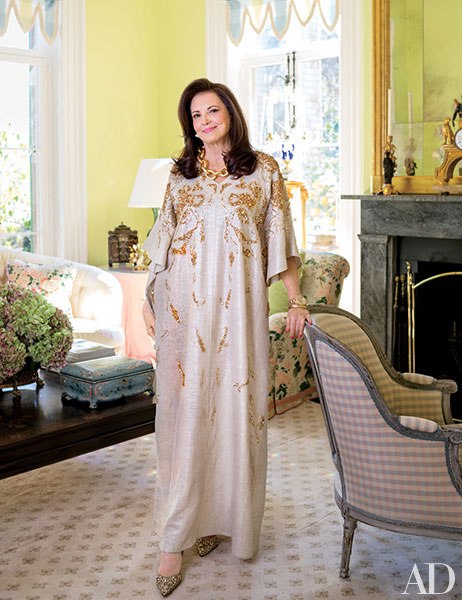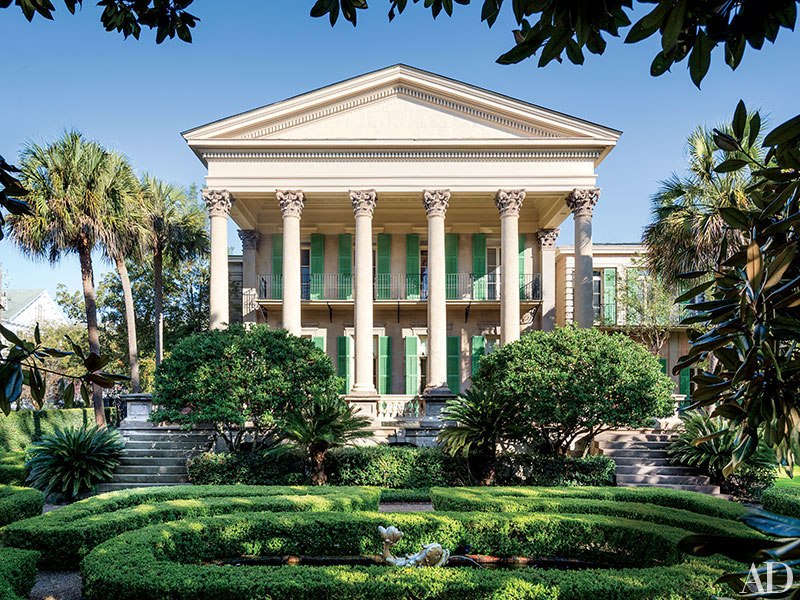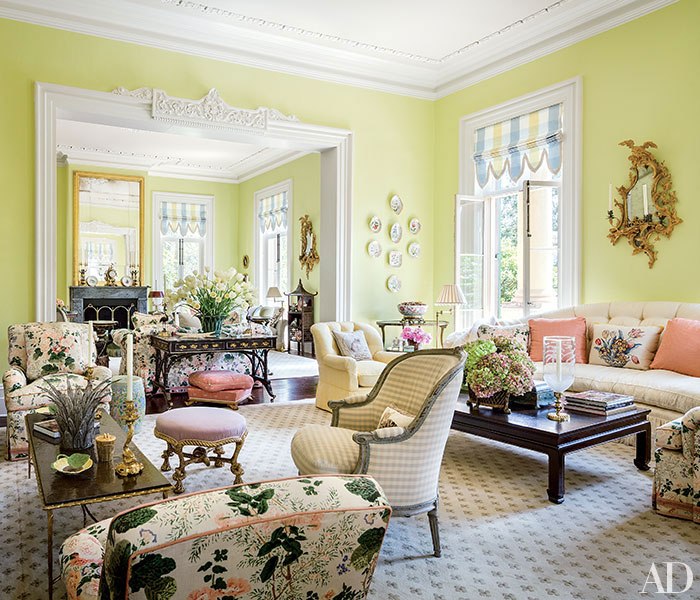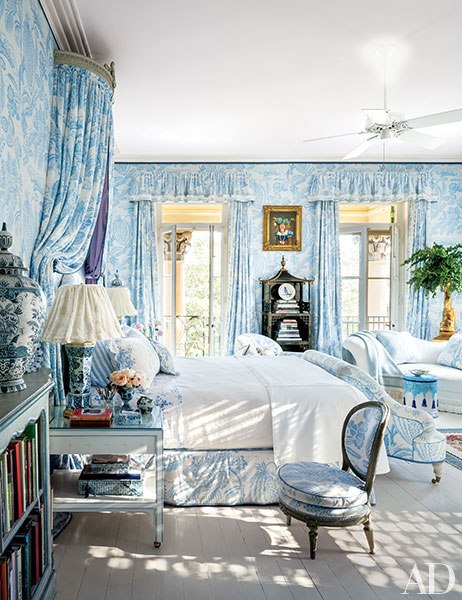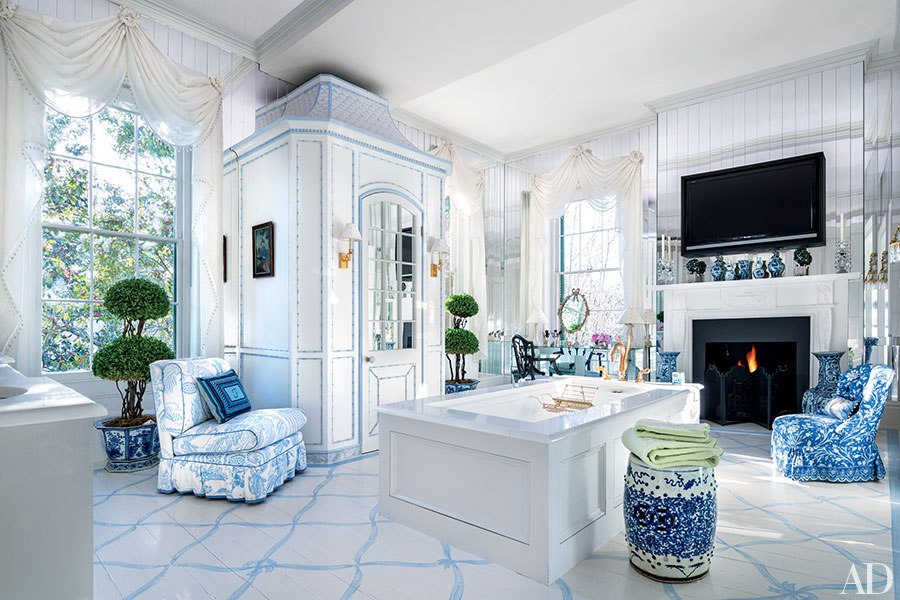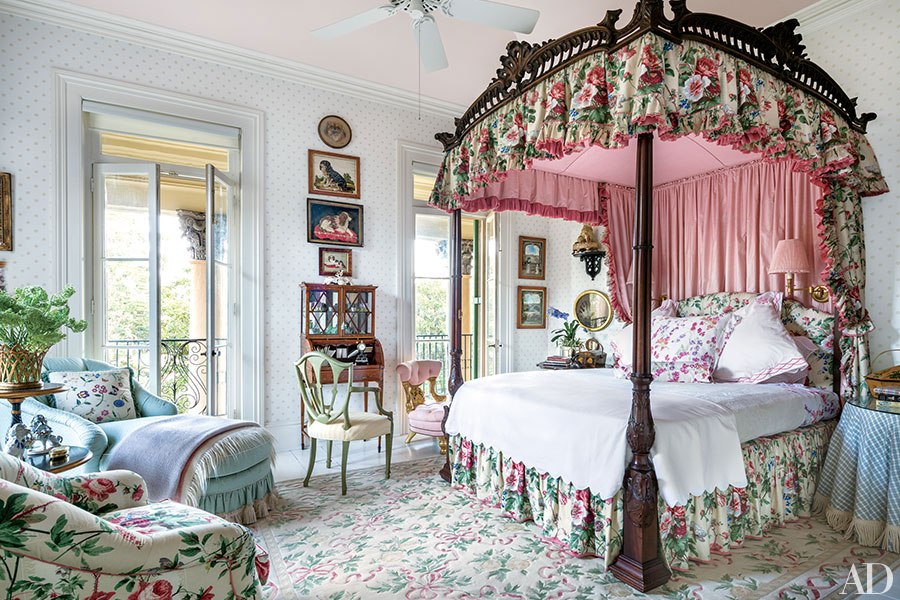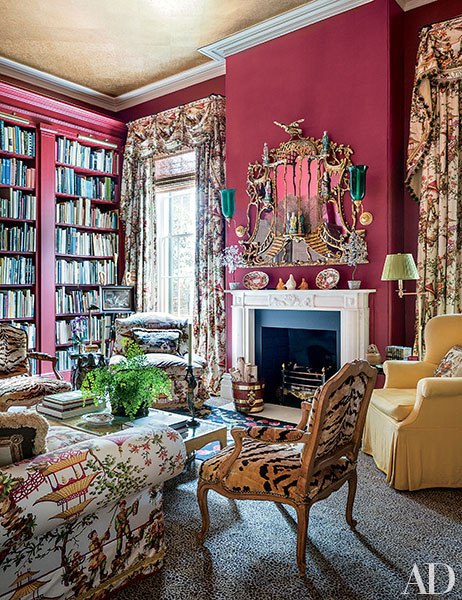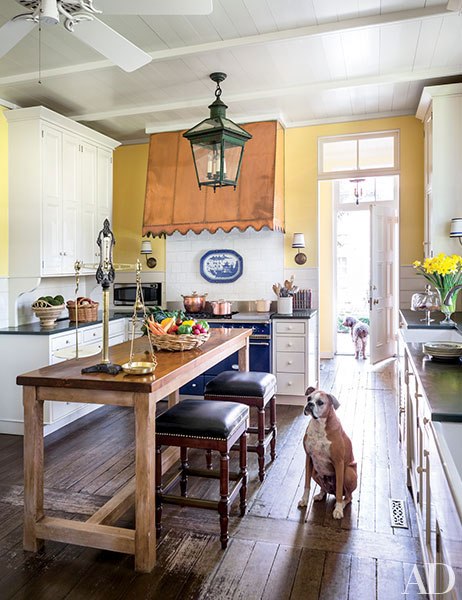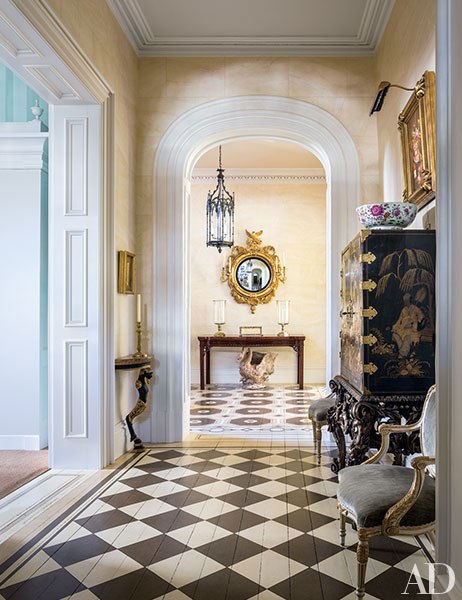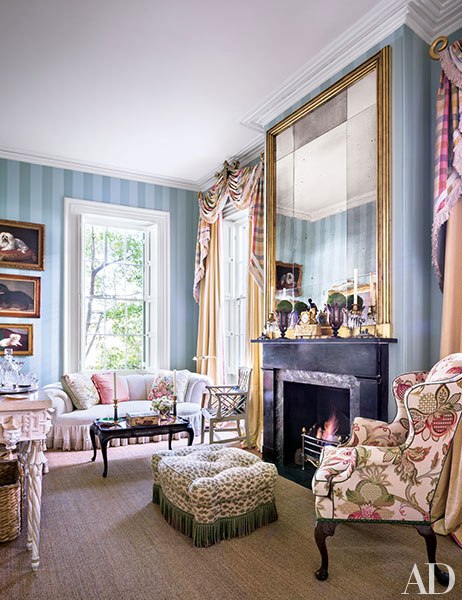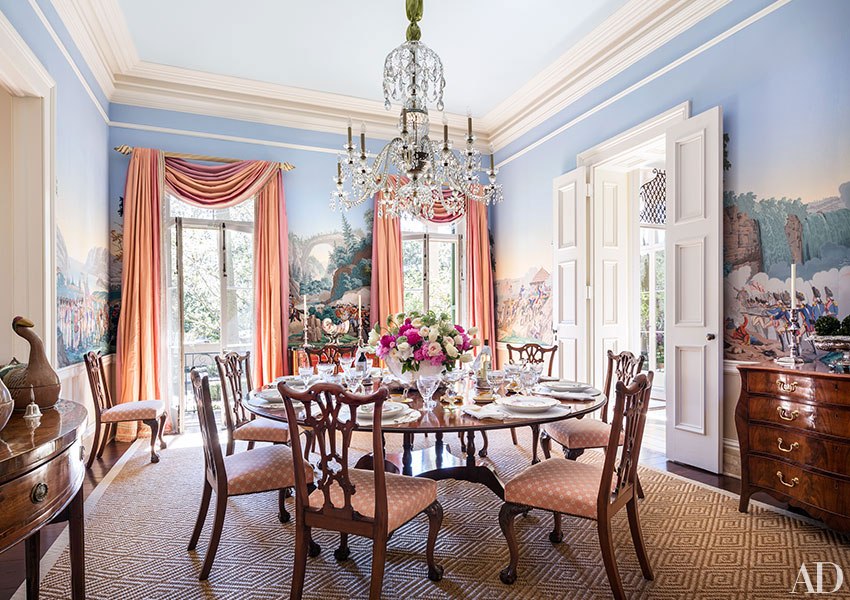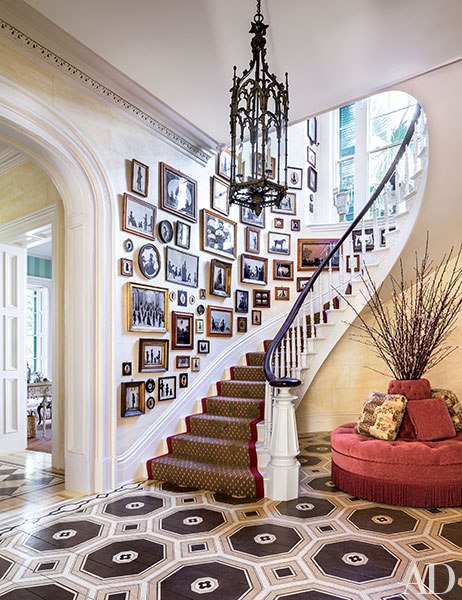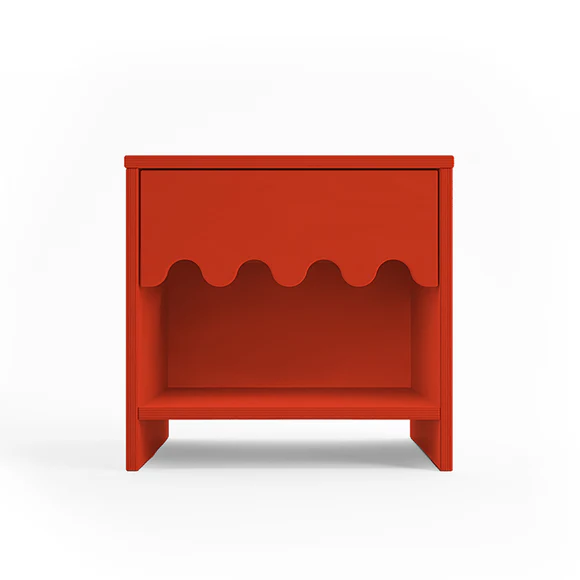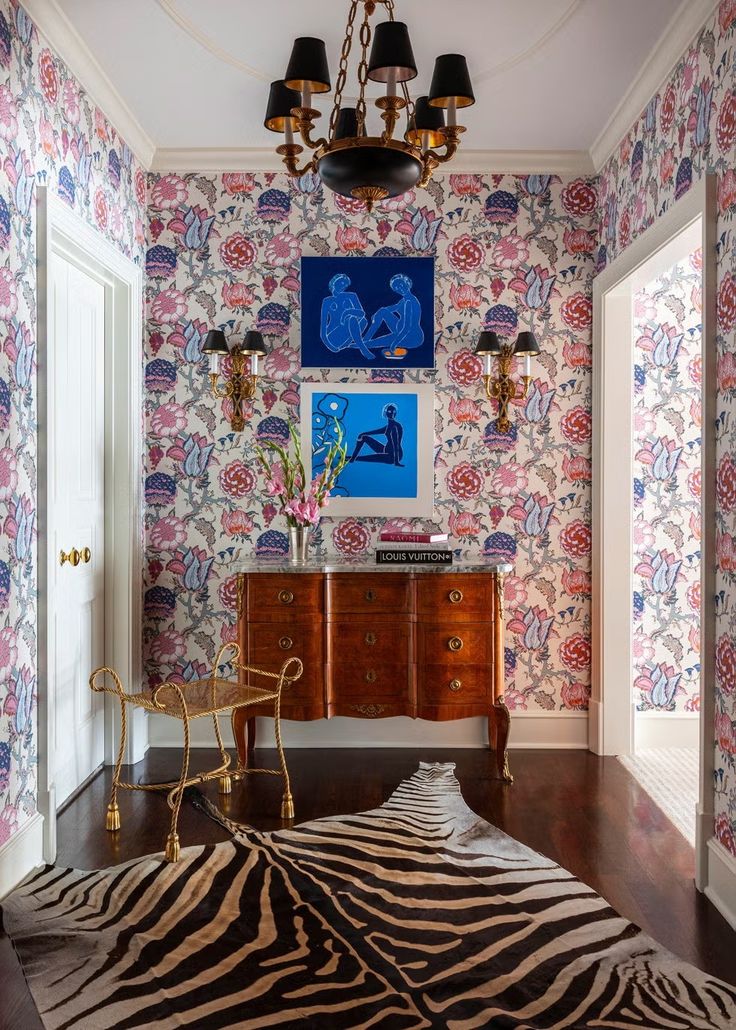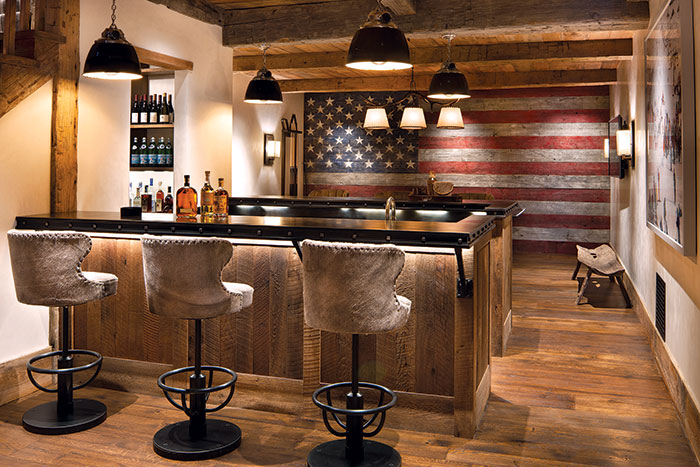Southern Charm by Mario Buatta
Two things I love are Mario Buatta (designer of my childhood home) and guilty pleasure reality TV show Southern Charm. As I watched the mesmerizing Season 2 finale week with a cameo by Mr. Buatta, I realized I need to share the quintessential work of Mario’s with a beautiful southern mansion seen weekly on the show…and also in AD.
With brilliant chintz, a snappy palette, and heirlooms galore, decorator Mario Buatta puts his joyous stamp on Patricia Altschul’s spectacular 1850s South Carolina mansion
Patricia Altschul, pictured above, commissioned designer Mario Buatta to revamp the interiors.
Christopher Mason | Scott Frances | Howard Christian
Working with Mario is always a great adventure, ” says longtime Manhattan society figure Patricia Altschul, fuchsia-caftaned and lounging on a pale-blue-checked bergère in the double drawing room of her new home in Charleston, South Carolina. Mario is, of course, Mario Buatta, the irrepressible New York decorator who glazed the walls of the space in a glowing shade he calls apple-green—a hue which Altschul describes as “very uplifting, whether the day is cloudy or sunny.”
Over Buatta’s 50-plus years in the business of lacquering and swagging, his clients have been remarkably loyal. The Virginia-born Altschul enlisted his services (and good cheer) for three previous large-scale projects, including Southerly, a 30-room Long Island, New York, estate that she shared with her late husband, Arthur G. Altschul, a distinguished financier. Six years ago she sold Southerly and snapped up a smaller but no less stupendous Greek Revival mansion in Charleston’s historic district and conscripted Buatta once more.
Ineffably grand—even by this courtly city’s exalted standards—the 9, 500-square-foot, ten-bedroom landmark was completed in the early 1850s for Isaac Jenkins Mikell, an exceptionally prosperous cotton planter. Gigantic columns carved from cypress support the monumental portico, each one crowned with a capital sporting ram’s heads. Beneath the pediment is a tiled piazza where Meyer lemon trees flourish in big clay pots, and between the house and the street is a tranquil walled garden of boxwood arabesques. The effect, Altschul enthuses, is like “living in a Palladian villa in Italy.”
For many years the Mikell mansion had been used as a public library, and it was later divided into apartments. Admired local contractor Richard Marks (whose eponymous firm also created a new butler’s pantry and an airy kitchen) was called in to restore the home to its historic glory. Every surface was revived, as were glorious details like the elaborate plaster ceiling medallions. The efforts were a great success: The house was honored at the Preservation Society of Charleston’s 2012 Carolopolis Awards for outstanding historic preservation.
Once the residence was back to its noble self, one vexing problem remained. “The place was too dark, ” recalls Altschul. Buatta is a bit blunter: “It had a frumpy beige interior.” To brighten things up, the designer had artisan Haleh Atabeigi paint the entrance hall’s floor white and then stencil it with a lively octagonal pattern based on Victorian tilework. Further lightening the space are walls faux-finished to resemble pale blocks of stone.
The house is furnished with many of Altschul’s favorite decorative elements and objects from her previous Buattafied addresses. Especially choice is the library’s splendid 1760s gilded chinoiserie mirror, which once hung at Keir House in Scotland. Buatta also festooned the dramatic main stairwell with a collection of dozens of striking 18th- and 19th-century silhouette portraits that Altschul inherited and has greatly expanded over time.
The contents may be familiar, but they seem refreshed by their trip below the Mason-Dixon Line. As Altschul marvels, “Everything looks entirely different here, because of the architecture.” The dining room incorporates a large round English table ringed by 19th-century Chippendale-style chairs, all once ensconced at Southerly. The space’s wall covering was brought down from the Long Island estate as well; the Zuber paper depicts Revolutionary War scenes that Altschul says represent a bit of ancestor worship: “A forebear of mine advised George Washington when he defeated Cornwallis at Yorktown.” As for the huge carpet that occupied Southerly’s living room, Buatta blithely chopped it in two and placed one half in each section of the drawing room.
The master bedroom replicates Altschul’s suite on Long Island, including the cheery cornflower-blue–and-white fabric that is used en suite. Decidedly different, however, are this bedroom’s views. “At Southerly I could lie in bed and look at the sea, ” Altschul observes. “Here it’s ram’s-head capitals and magnolias.”
Before Buatta’s decor was fully installed, the renovated house and its couture-clad chatelaine made their small-screen debut on Bravo’s Southern Charm, a reality-television series created by Altschul’s son and costar, Whitney Sudler-Smith, who has irreverently described Buatta as “the Dame Edna of decorating.” Renewed for a second season, the frothy program follows the high jinks of a cadre of dapper trust-funders. Altschul is the resident madcap grande dame, a role she clearly enjoys, delivering wry remarks about the cast’s romantic divertissements and her son’s raffish confreres—and when she is ready for a cocktail on the show, she brightly announces, “It’s time for my medicine.”
Buatta himself appeared on Southern Charm as a celebrity aesthete dispensing words of wisdom. (His savoir faire is also being captured in a documentary about his career by Douglas Keeve, who limned fashion star Isaac Mizrahi’s life in the 1995 movie Unzipped.) In that particular episode, the decorator suggests that Altschul enshrine the ashes of her beloved cat, Rocky, who had ascended to feline heaven, in a delft jar above her headboard. Given the hostess’s nonplussed reaction, it seems likely that this is one Buatta design tip she will choose to ignore.
Step inside Patricia Altschul’s historic Charleston, South Carolina, home.
EXTERIOR
An antebellum landmark built in the early 1850s, the Isaac Jenkins Mikell house in Charleston, South Carolina, is owned by Patricia Altschul.
LIVING ROOM
To soften the wood floor of the apple-green double drawing room, Mario Buatta took a Stark carpet from Altschul’s former Long Island, New York, estate and cut it in half, dividing it between the spaces. A Lee Jofa floral upholsters several armchairs and the love seat, and a Colefax and Fowler check covers the French bergère. Both the Regency sofa table in the doorway and the cocktail table on the right are from Philip Colleck.
MASTER BEDROOM
A Manuel Canovas fabric lavishes the master bedroom, where a Donald Roller Wilson painting is displayed above a 19th-century chinoiserie étagère from Philip Colleck.
MASTER BATH
In the master bath, the toilet is concealed in a tall chinoiserie cabinet; a Manuel Canovas print covers the slipper chair at left, a Brunschwig & Fils fabric was used on the chair at right, and the garden stool is from John Rosselli Antiques.
GUEST ROOM
19th-century canopy bed dressed with a Colefax and Fowler floral dominates a guest room; the bed linens are by D. Porthault, and the carpet is by Stark.
LIBRARY
In the cherry-red library, a chinoiserie fabric was used for curtains and upholstery; the gilded 18th-century mirror, from Gracie, once hung in Scotland’s Keir House, the tiger-stripe velvet is by Brunschwig & Fils, and the ocelot-spot carpet is by Stark.
KITCHEN
Smoochie, a boxer, and Monty, a Lagotto Romagnolo, pause in the kitchen; the table is from Ann-Morris.
ENTRANCE HALL
As seen from the entrance hall, a Regency mirror from Mallett is mounted in the stair hall, above an 18th-century table from Florian Papp.
MORNING ROOM
Colefax and Fowler striped wallpaper sheathes the morning room; the Mario Buatta–designed ottoman is clad in a Brunschwig & Fils cotton.
DINING ROOM
An antique Zuber wallpaper depicting Revolutionary War scenes lines the dining room; the 19th-century Waterford chandelier is from Nesle, and the dining table is English.
STAIR HALL
Antique silhouettes hang in the stair hall, which is furnished with a borne covered in a Brunschwig & Fils chenille; the lantern is 19th-century Gothic Revival, the stair runner is by Stark, and Haleh Atabeigi painted the floor.
Joni at Cote de Texas did an incredible post featuring the house, the history , the interiors and so much more. Check it out HERE.
HERE is the NY Fifth Avenue Apartment of Patricia by Mario Buatta.
Also do not miss Life Lessons from Southern Charm’s Patricia Altschul from Vogue.
Be sure to subscribe to THE ENGLISH ROOM for extra news, giveaways and discounts.
Let’s get friendly on Facebook, Twitter, Pinterest, Tumblr and Instagram.
Please feel free to contact The English Room if you are interested in our interior design services in Charlotte or beyond.



